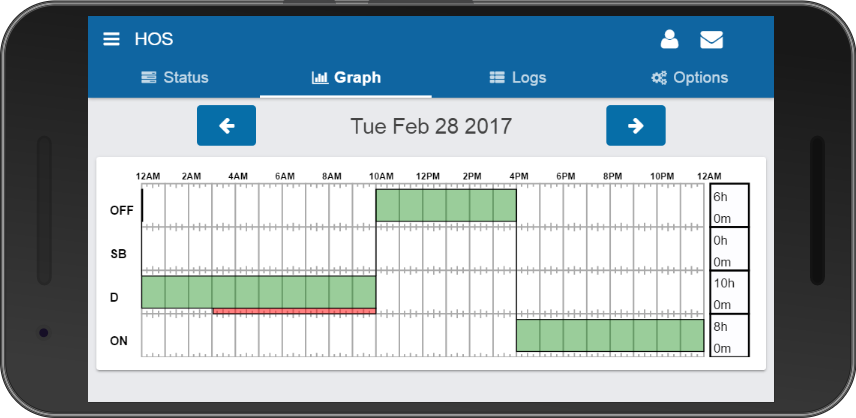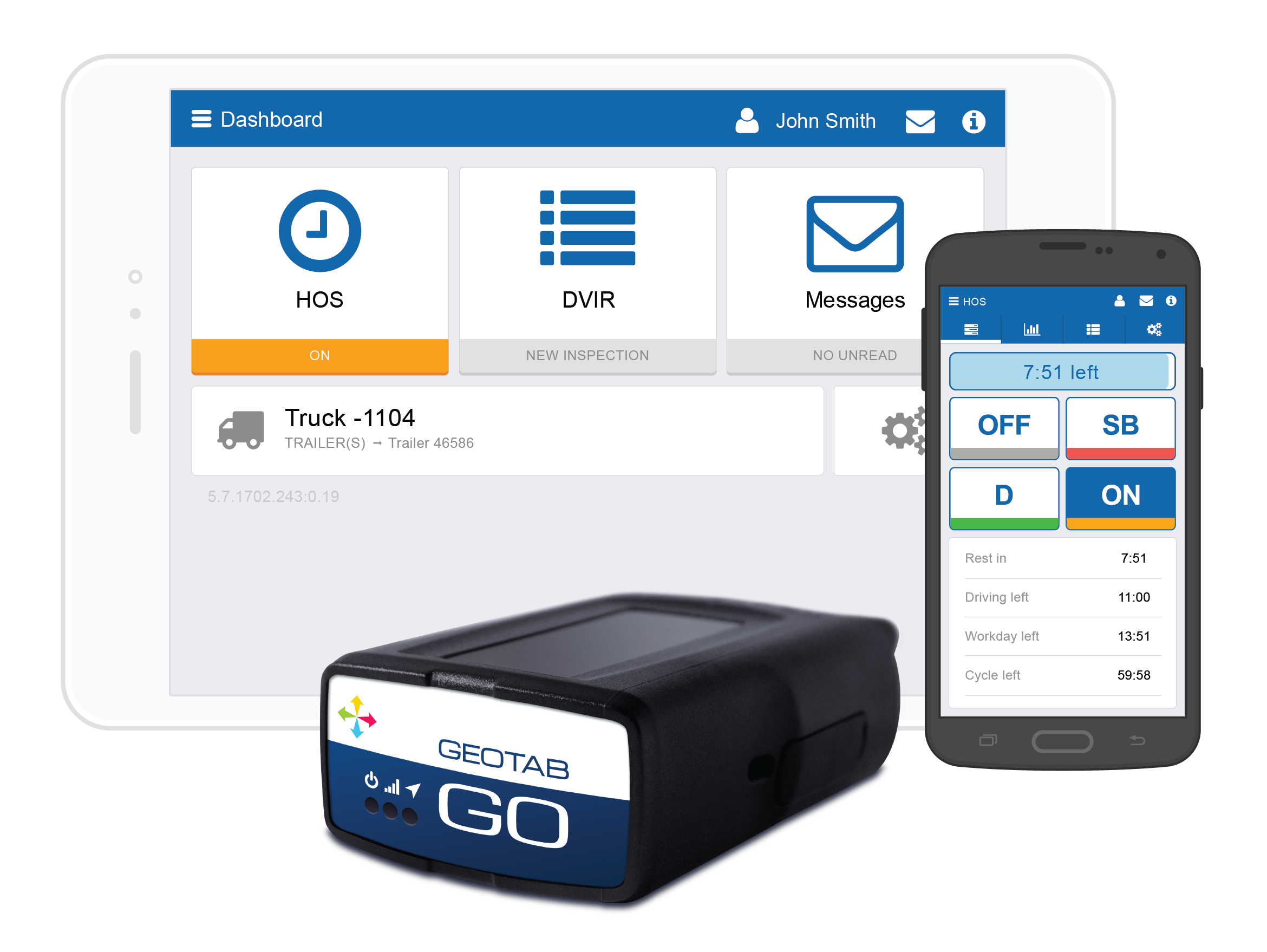
The Comprehensive DOT and FMCSA Hours of Service Guide (U.S.)
Last updated on February 27, 2024 in Compliance by Denise Rondini | 12 minute read
Table of contents
- Hours of Service overview
- What are DOT Hours of Service?
- Who is subject to Hours of Service regulations?
- Where do Hours of Service regulations apply?
- How many hours are you allowed to drive in a day?
- HOS rules overview
- Who is exempt from Hours of Service?
- Records of duty status (RODs)
- What are the most common HOS violations?
- How to record Hours of Service with an ELD
- Hours of Service glossary
The Federal Motor Carrier Administration’s Hours of Service regulations affect every commercial vehicle driver on the road.
Staying up-to-date with Hours of Service regulations is a critical task for both drivers and carriers. To support FMCSA and DOT compliance efforts, we have put together this eld recap hours overview of the regulations and rulesets. In this guide to Hours of Service (HOS) for commercial vehicle drivers, you will find a basic introduction to Hours of Service rules in the United States, an overview of HOS rulesets and driving limits, and a glossary of important terms.
See also:
U.S. Department of Transportation modernizes Hours of Service rules
FMCSA revises Hours of Service Final Rule: What you need to know
Hours of Service overview
In this guide to Hours of Service (HOS) for commercial vehicle drivers, you will find a basic introduction to Hours of Service rules in the United States, an overview of HOS rulesets and driving limits, and a glossary of important terms.
What are DOT Hours of Service?
Hours of Service (HOS) regulations help ensure overall road safety by governing the number of hours truck drivers can drive and work. In general, HOS rules regulate the maximum number of hours that can be driven, specify mandatory break times and time off, and duty cycles.
You can find the complete regulations in Part 395 Hours of Service of Drivers of the Federal Motor Carrier Safety Regulations. The Hours of Service of Drivers Final Rule was published in December 2011. The Federal Motor Carrier Service Administration (FMCSA) oversees (but is not limited to) all interstate regulations and mandates any changes needed.
Many countries around the world have their own HOS regulations, such as Australia, Brazil, and Canada. This article will focus on driving requirements in the United States, giving a general overview of how HOS is managed and regulated.

Geotab Drive compliance graph showing duty status for 24-hour period.
Who is subject to Hours of Service regulations?
HOS regulations apply to drivers who operate a commercial motor vehicle (CMV) in the United States, no matter whether they are from the United States or an international motor carrier from Canada or Mexico. A CMV is defined as a vehicle (with or without a trailer) which satisfies any of the following conditions:
- Weighs (including any load) at least 10,001 lbs. (4,536 kg), OR
- Has a gross vehicle weight rating or gross combination weight rating of at least 10,001 lbs. (4,536 kg), OR
- Transports hazardous materials in a quantity requiring placards
- Made intentionally or used to transport 16 or more passengers, including the driver, without compensation
- Made intentionally or used to transport 9 or more passengers, including the driver, for compensation
For more information, see our Quick Guide to the FMCSA’s ELD Mandate
Where do Hours of Service regulations apply?
Many countries around the world have Hours of Service regulations in place. In the U.S., there are two different sets of regulatory provisions for Hours of Service: Interstate and Intrastate. A common misconception is that interstate commerce refers to vehicles themselves or the driver crossing state borders, but this is not the case.
Interstate commerce refers strictly to the transfer of goods, services and passengers across state borders. Drivers who are not involved in interstate commerce at all times must continue to comply with FMCSA HOS regulations for at least 7 or 8 days after they stop performing interstate commerce, depending on what exact ruleset they operate under.
Intrastate commerce refers to the transfer of goods, services and passengers that stay within the borders of one state. If you are operating in intrastate commerce only, the federal HOS regulations do not apply to you. However, each state creates their own HOS regulations for intrastate commerce drivers, such as the Texas Transportation Code for Texas intrastate drivers.
Vehicles transporting hazardous material in large quantities, even during times in which they are not carrying any load must comply with FMCSA HOS regulations not intrastate regulations.
How many hours are you allowed to drive in a day?
It is important to note that there are different Hours of Service rules depending on whether you are a property or passenger-carrying driver.
Property-carrying and passenger-carrying drivers
A property carrier is a company that transports goods or services, such as one that delivers packaged food or a moving company. A passenger carrier transports people, such as a city or tour bus. Both property and passenger carriers have various sets of rules they must adhere to, otherwise known as a ruleset. These rulesets have different exemptions as well.
Driving limits overview for property-carrying drivers
Under the property-carrying ruleset, truck drivers must follow several important limits:
- 14-hour “driving window”
- 11-hour driving limit
- 60-hour/7-day and 70-hour/8-day limits
HOS rules overview
In this section, we’ll explain each of the HOS rulesets in further detail.
What is the 14-hour rule? (Property-carrying drivers)
The 14-hour workday limit means that once a driver comes back ON-Duty after 10 consecutive hours of OFF-Duty time, that driver cannot drive beyond 14 consecutive hours.
This workday limit is the total number of hours a driver can work in a day and is designed to prevent driver fatigue. It consists of driving, rest limits, and various OFF-Duty breaks (i.e. getting lunch, mandatory rest limit, etc.). This 14 consecutive hour driving window does not change even if the driver takes time off to take a break or nap.
Example:
If a driver drives 8 hours, takes a 1-hour OFF-Duty time for lunch, then drives for 2 hours followed by an additional 3 hours of OFF-Duty time, that driver has hit their 14-hour limit despite not reaching an 11-hour driving limit.
What is the passenger-carrying duty limit?
For passenger-carrying vehicles, a 15-hour duty limit applies, instead of a workday limit. Duty Limit is non-consecutive, meaning that any time spent in OFF-Duty or the sleeper berth does not count toward the limit. The 15-hour duty limit is used for passenger carriers and some intrastate property carriers to help the driver accomplish more non-driving related tasks in the day. It also accommodates long breaks in between picking up and dropping off cargo.
11-hour driving limit
Within the 14-hour workday, property-carrying drivers are only permitted to drive their truck for a maximum of 11 hours after 10 consecutive hours of OFF-Duty time. This means they cannot drive for more than 11 hours in a day without a long break of OFF-Duty time.

What is the DOT 70 hour rule?
The DOT 70 hour Rule is the total time spent Driving and ON-Duty, and cannot exceed 70 hours in any 8-day period (or 60 hours in any 7-day period). In other words, drivers have a limited number of hours they can be ON-Duty per cycle (week).
To calculate this total, add up the time spent Driving and ON-Duty today, plus the prior 7 days. That total cannot be more than 70 hours. Drivers cannot drive after they have reached 60/70 hours of ON-Duty time in 7/8 consecutive days.
A driver may gain back time at midnight when the oldest day in his 8-day window falls out of the time range. To completely reset the 70-hour clock, it requires a 34-hour restart.
Example:
A driver can be ON-Duty a maximum 60 hours in a 7 day cycle. In order to reset the cycle, drivers must take a consecutive 34 hours of OFF-Duty. This can be done at any time as long as the hours do not exceed 60 hours.
What is a 34-hour restart?
Once a driver has worked a total of 60 hours in the past 7 days (or 70 hours in 8 days), they have hit their limit. They must be OFF-Duty for a consecutive 34 hours in order to work again. This is also referred to as the 34-hour reset or 34-hour restart.
Drivers must have a certain number of non-working/off hours within a 24-hour time period to give them a rest from driving and other miscellaneous tasks. Drivers can do their OFF-duty time in the sleeper berth, in a hotel, at home, or other areas outside of actual work. The driver is considered OFF-Duty as soon as they are no longer in transit with the goods, services or passengers. They can drive while OFF-Duty, but not for any work-related tasks such as fueling the vehicle or taking it to the mechanic.
Previously, an extra restriction for the 34-hour restart had been considered, requiring two OFF-Duty periods during 1 a.m. to 5 a.m. and a once per week provision. However, based on a Department of Transportation (DOT) study of truckers conducted by the FMCSA and Virginia Tech which showed that the changes did not benefit driver safety, the requirements were struck down.
Sleeper berth time
The “sleeper berth” refers to the cab in the back of the truck which can contain a bed, desk, TV, and refrigerator. Drivers can use the time spent in the sleeper berth to count toward their mandatory rest-limits or their OFF-Duty time.
If drivers have a 10-hour OFF-Duty time, they can spend the full 10 hours in the sleeper berth or they can do 8 hours of OFF-Duty, followed by some driving then 2-hours of OFF-Duty time which would count toward their total OFF-Duty time.
Rest breaks
Rest time is the required break for a CMV driver after a certain number of hours driven. For example, if a property-carrying driver drives 8 continuous hours, he or she is required to take a 30-minute break.
This is not something that is optional for the drivers, rather this is a mandatory break they must take. Breaks can be logged as any status that is not driving.
Who is exempt from Hours of Service?
There are many different exemptions and exceptions that extend or change the categories above. For a summary of some of the most common exemptions for Hours of Service, please see below.
List of common HOS exemptions
16-hour rule: Allows drivers to add 2 hours onto their 14 hour workday within certain conditions.
Adverse driving conditions: Lengthens the driving limit / ON-Duty limit by up to 2 hours due to unforeseen driving conditions. Adverse driving conditions covered include snow, fog or unexpected traffic shut-down, but do not cover more common occurrences such as traffic congestion in rush hour.
When Hurricane Harvey hit the Gulf Coast in 2017, the FMCSA issued a Regional Declaration of Emergency for Texas and Louisiana and gave drivers an exemption for Parts 390-399 of the Federal Motor Carrier Safety Regulations to allow fast response in delivering relief supplies and transporting people. See our Hurricane Harvey timelapse showing the dramatic impact on fleet activity as reported by Geotab GO devices.
Oil transport: Allows drivers in the oil transportation industry to restart their cumulative work week after 24 consecutive hours of OFF-Duty Time.
Salesperson: Drivers, who are also salespersons, do not have to comply with the 60-hour/7-day limit or the 70-hour/8-day limit.
Short-haul: Drivers of “short-haul” vehicles do not need to take a half-hour rest break after 8 hours of ON-Duty.
Wait-at-well: Drivers in oil-well transportation service can use time spent waiting at an oil well site as OFF-Duty time or to satisfy the 30-minute break.

Records of duty status (RODs)
In order to prove that the driver has followed the regulations, drivers must present roadside inspection officers with documented logs, also known as a record of duty status (RODs). The requirements for a driver’s record of duty status are detailed in 49 CFR 395.8.
RODs logs must include:
- 24-hour period grid
- Date (Day, Month, Year)
- Total miles driven
- Truck/Tractor/Trailer number
- Name of carrier
- Main office address
- Driver’s certification verifying logs
- Name of co-driver
- Time zone
- Total hours spent in: OFF-Duty, ON-Duty, Sleeper Berth, Driving
- Shipping document number/name of shipper/name of commodity
- Annotations
Annotations are used within logs and give a description of what happened, whether it be a duty status change or forgetting to apply for an exemption. This allows the driver to inform the officer and the fleet manager, upon request, of their whereabouts at a certain time. Annotations can be as simple as “taking lunch,” or they can be more detailed, as decided by the carrier.
It is important to note that RODs belong to the individual driver, not the vehicle or the motor carrier. If the driver changes vehicles, their RODs logs will stay with them and unchanged. In cases of co-drivers or team-drivers (where there are multiple drivers in the same vehicle) each driver must have their own RODS logs. Drivers must ensure that their logs are clear and accurate as possible so they can be easily reviewed during an inspection if necessary.
Submitting logs to roadside inspectors
The ELD rule requires drivers to use either an electronic logging device (ELD) or an automatic on board recording device (AOBRD) for records of duty status (RODS). Paper logbooks are no longer allowed for drivers subject to the rule. Once the rule comes into full effect on December 19, 2019, only self-certified ELDs can be used.
In the event of a roadside inspection, drivers must have their RODs readily available. All RODs must be compliant with their ruleset, or else the driver will be subject to fines.
What are the most common HOS violations?
While there can be any number of HOS violations, these are the most common:
- Operating past 14 hours ON-duty
- Driving over 60/70 hours in 7/8 days
- Violating the 11-hour driving limit
- No Record of Duty Status
- False logs
- Wrong class license
Violations can be discovered in a number of ways: :
- Your carrier keeps track of your hours and will know if you are in violation.
- The police can discover a violation during a roadside inspection.
- The DOT can catch you at a weigh station if your company happens to get audited.
- If you get into a collision while operating over an HOS limit.
What is the fine or penalty for an Hours of Service violation?
Violating HOS rules can lead to a variety of penalties for both the driver and carrier:
- Drivers may be placed on shut down (at roadside) until they have accumulated enough off-duty time to be back in compliance.
- State and local law enforcement officials may assess fines.
- The Federal Motor Carrier Safety Administration may levy civil penalties on a driver or carrier, ranging from $1,000 to $16,000 per violation depending on the severity. The minimum and maximum dollar amounts for these fines are routinely adjusted to reflect inflation, as outlined in the Federal Civil Penalties Inflation Adjustment Act Improvements Act of 2015.
- A carrier's safety rating can be downgraded for a pattern of violations.
- Federal criminal penalties can be brought against carriers who knowingly and willfully allow or require violations; or against drivers who knowingly and willfully violate the regulations. These can include fines, license suspension, and jail time.
How to record Hours of Service with an ELD
Historically, drivers have used paper logs to record their Hours of Service. However, with the introduction of the ELD Mandate in the United States, drivers and carriers are required to use electronic logging devices for record-keeping.
Geotab ELD is a fleet compliance management solution for monitoring and recording HOS, including RODS and Driver Vehicle Inspection Reports (DVIR).
Drivers log their Hours of Service from the Geotab Drive mobile app which can be used on a smartphone or tablet. In the Geotab Drive HOS screen, drivers can select and change their duty status. They can also see a summary of the time remaining in each duty status, such as Rest in, Driving left, Workday left, and Cycle left.

A blue bar near the top of the screen shows the time left driving, and will turn red if the driver goes into violation. Geotab Drive has automatic duty status changes, meaning that when the truck is in motion, the duty status will change to D (Drive).
As of December 16, 2019, all carriers subject to the ELD mandate, are required to use electronic logging devices.
Learn more about electronic logs and fleet compliance with Geotab.
Hours of Service glossary
Important trucking acronyms
AOBRD: Automatic On Board Recording Device
CMV: Commercial Motor Vehicle
DOT: Department of Transportation
DVIR: Driver Vehicle Inspection Reports
ELD: Electronic Logging Device
FMCSA: Federal Motor Carrier Safety Administration
HOS: Hours of Service
RODs: Records of Duty Status
Duty status categories
D (Drive): Time spent operating the CMV.
OFF (OFF-Duty): Time that the driver is relieved of all duty and responsibility for performing work. To be considered OFF-Duty time, drivers must be free to pursue activities of their choice and leave the place where their vehicle is parked.
ON (ON-Duty): All the time that drivers spend working and being compensated.
SB (Sleeper Berth): Similar to OFF-Duty.
Additional HOS terms
34-hour restart: The driver must be OFF-Duty for a consecutive 34 hours before starting work again.
DOT Officer: Officer that is hired by a Department of Transportation (DOT) to enforce set regulations
Drive’s logs: Analogous with Record of Duty Status Logs
Drive status: Time spent driving the vehicle.
ELD (Electronic Logging Device): Technology that automatically records a driver’s driving time and other aspects of the Hours of Service (HOS) records. For a more detailed description, see: What is an ELD?
Fine: Violations of hours of service rules can result in fines or other penalties such as being placed out of service or a reduction in the driver or carrier’s safety rating, depending on the severity of the violation. When a driver is in violation of HOS regulations they must pay a fine and stop driving until they are no longer in violation.
FMCSA: Federal Motor Carrier Service Administration is an agency of the United States Federal Department of Transportation. They regulate all interstate CMVs and international CMVs.
Hazmat (Hazardous Material): Any materials deemed hazardous by the FMCSA, such as compressed gasses or spontaneously combustible material, require a placard on the truck and special training for transporting (as per the FMCSA regulations).
Hours of Service: Safety regulations which oversee the time spent by drivers of commercial vehicles: driving, on-duty, off-duty, and resting.
Inspection: Carried out by a DOT officer to ensure that the driver did not violate HOS regulations and other various factors of the trucking industry
Interstate commerce: The transfer of goods, services and passengers across state borders.
Intrastate commerce: The transfer of goods, services and passengers that stay within the borders of one state.
Logbook: Form which tracks the Hours of Service statuses of a driver for 24-hours
Motor carrier: Company or person supplying transportation of property or passengers via CMVs.
OFF-Duty status: Leisure time or rest time for a driver
ON-Duty status: When a driver is doing tasks that would otherwise be known as work, that is not driving
Team drivers (co-drivers): Two or more drivers that alternate between the passenger and the driver’s seat of a vehicle. Typically used for time sensitive deliveries, like moving trucks.
For the complete and updated Hours of Service regulations, please see the FMCSA website.
References:
- FMCSA, Interstate Truck Driver’s Guide to Hours of Service (Mar 2015). Retrieved from: https://www.fmcsa.dot.gov/sites/fmcsa.dot.gov/files/docs/Drivers%20Guide%20to%20HOS%202015_508.pdf
While Geotab recognizes our place as a self-registered ELD manufacturer and provider and we will answer questions regarding those Hours of Service (HOS) ruleset options we provide, neither Geotab nor any of its employees, officers or agents can offer legal advice to any resellers or customers concerning which HOS ruleset(s) or exemption(s) may apply to any particular situation. Please contact your local DOT department or refer to the FMCSA website at https://www.fmcsa.dot.gov/ for questions Geotab is unable to answer.
Originally published December 2012. Updated November 2020.
If you liked this post, let us know!
Disclaimer
Geotab's blog posts are intended to provide information and encourage discussion on topics of interest to the telematics community at large. Geotab is not providing technical, professional or legal advice through these blog posts. While every effort has been made to ensure the information in this blog post is timely and accurate, errors and omissions may occur, and the information presented here may become out-of-date with the passage of time.
Get industry tips and insights
Sign up for monthly news and tips from our award-winning fleet management blog. You can unsubscribe at any time.
Republish this article for free
Other posts you might like

Electronic logs: unlocking the benefits for trucking
April 15, 2024

Electronic Logbooks: Mandates, Compliance, & Implementation
April 15, 2024

ELD self-certification: What you need to know
April 10, 2024

The Impact of the California Clean Truck Check on Your Fleet
March 27, 2024






